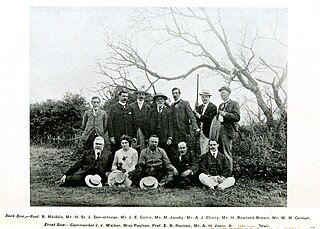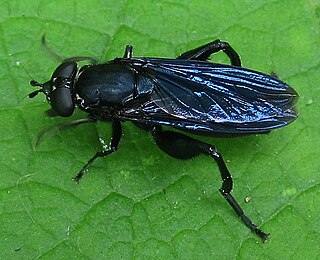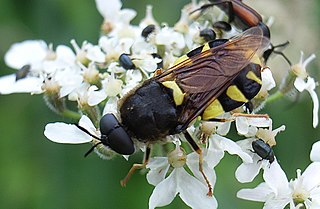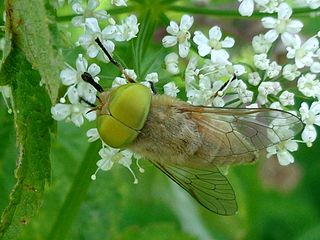
Horace St. John Kelly Donisthorpe was an eccentric British myrmecologist and coleopterist, memorable in part for his enthusiastic championing of the renaming of the genus Lasius after him as Donisthorpea, and for his many claims of discovering new species of beetles and ants.
Francis Polkinghorne Pascoe was an English entomologist mainly interested in beetles.

James Charles Dale was an English naturalist who devoted almost all of his adult life to entomology.

Adam White was a Scottish zoologist.

Xylota is a Holarctic genus of hoverflies similar in structure to the related genera Chalcosyrphus and Brachypalpoides. As the larvae are saprophytic they're usually found in rotting wood. The adult flies are generally associated with woodland and woodland edges and can often be seen running over the upper sides of leaves. Unlike other syrphids the adults of many species rarely visit flowers preferring instead to gather pollen from leaf surfaces. There are over 100 described species of which 12 can be found in Europe. Seven species have been recorded in Britain. Identification of species has been difficult and identifiction by photographs is risky.

Chalcosyrphus is a genus of hoverflies in the subfamily Eristalinae. Many species exhibit some degree of mimicry of various sawflies and other hymenopterans and are often brightly coloured or metallic in hue. The adults are similar in structure and behavior to the related genus Xylota but differ in larval morphology. They can be found throughout Europe, Asia, and North America and seem to prefer damper, boggy habitats. The larvae are saproxylic feeders in rotten wood in these habitats.

Protopaussus is a genus of ground beetles in the family Carabidae, the sole genus of the tribe Protopaussini. It is found in Indomalaya and temperate Asia.

Stratiomys is a genus of flies in the family Stratiomyidae.

Cosmisoma fasciculatum is a species of beetle in the family Cerambycidae. It was described by Guillaume-Antoine Olivier in 1795 and can be found in French Guiana and north central Brasil.

Parevander xanthomelas is a species of beetle in the family Cerambycidae. It was described by Félix Édouard Guérin-Méneville in 1844, and has been classified in the genus Parevander since the circumscription of that genus by Per Olof Christopher Aurivillius in 1912.

Cylindromyia brassicaria is a species of fly in the family Tachinidae.

Neoptychodes trilineatus is a species of flat-faced longhorn beetles in the subfamily Lamiinae.
Eburia postica is a species of longhorn beetle found in Jamaica.

Eburia tetrastalacta is a species of beetle in the family Cerambycidae.
Stizocera melanura is a species of beetle in the family Cerambycidae. It was described by W. F. Erichson in 1848. It was found in British Guiana.
Ropica illiterata is a species of longhorn beetle in the family Cerambycidae. It was described by Pascoe in 1865. It is known from Borneo and Sumatra.

Leptomorphus is a genus of fungus gnats in the family Mycetophilidae. There are about 8 described species in Leptomorphus.

Atylotus is a genus of horse flies in the family Tabanidae.














